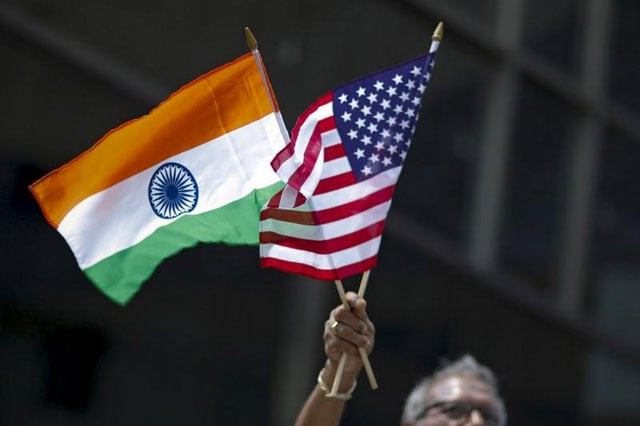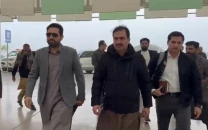Deconstructing the India-US strategic deal
The cost of this India-US lavish marriage has been paid by ordinary Indians living below the poverty line

PHOTO: Reuters
The Modi government saw the offer feeding into its vision of a stronger and assertive India. The fringe communists along with a handful of ultra-nationalists, however, were left fuming for sacrificing sovereignty without taking parliament into confidence.
The Logistics Exchange Memorandum of Agreement (LEMOA) provides for exchange of logistics support, supplies and services between the two countries’ armed forces. The agreement applies exclusively to authorised port visits, joint exercises, joint training, humanitarian assistance and disaster relief efforts. It streamlines relations between the two militaries, allowing, for instance, refuelling without having to come up with a new agreement each time, analysts have said. Though the US has over 100 such agreements with other partner nations cementing systemic inter¬operability with respective militaries, the India-specific one is an amended version of the Acquisition and Cross-Servicing Agreement (ACSA) Washington has with many NATO members.
Pakistan apprehensive of US-India defence deal
By dint of the deal, India’s military top brass and the US will have "enhanced operational readiness and cost effective mutual support." Both the militaries will be able to use each other’s hardware, rations, medical and logistical services, communication resources and active operational support during combat.
Under the Communication and Information Security Memorandum of Agreement (CISMOA), the US will give India access to its propriety-encrypted communications equipment and systems, including aircraft and warships. Basic Exchange and Cooperation Agreement (BECA) would set up a framework through which the US could share sensitive data with India to aid targeting and navigation.
The deal branding ‘a major defense partner of the United States’ is the result of exceptionally fast-paced diplomatic engagements between India’s defense minister and his American counterpart, Ash Carter. The duo met six times, including bilateral visits. The groundwork for the landmark engagement with the US was carried out in Indian premier Atal Bihari Vajpayee’s rule while the actual singing of the New Framework for Defense Cooperation in June 2005.
The agreement is in sync with Modi’s propagated Make-in-India initiative, as it will bring America’s innovative and advanced opportunities in defense technology and trade cooperation to Delhi.
Mutually beneficial
The cost of this India-US lavish marriage has been paid by ordinary Indians living below the poverty line. By abandoning the so-called independent defense policy, India has gained access to four US military bases in the Philippines to forward American interest in the South China Sea vis-à-vis China. In return for taking on rising China on its behest, the US will provide critical military assistance during any conflict, if sought.
Though Washington can’t sell the armed version of the Predator as per export control law, at least for now, Delhi will start receiving 22 Predator Guardian drones next year. India’s entry in the Missile Technology Control Regime paved the way for sale of the drone. The two countries have already finished their homework for the multi-billion dollars worth nuclear deal in preemption to India’s entry in the Nuclear Suppliers’ Club. Thus, it’s wrong to assume that China is blocking India’s membership in the NSG just for the sake of Pakistan. The slot will bring a whole new world of critical resources within India’s reach.
Meanwhile, the US is providing India with a new system to launch heavier fighter planes off the deck of its 65,000-tonne aircraft carrier, INS Vishal. Modi could not resist the temptation of leapfrogging a generation of technology over China and Pakistan. The process may find no hiccups after January 20 when Trump takes oath as a six-member Indian team is already engaging with his aides in New York.
Our security relationship far wider with India than Pakistan, says US envoy
Since 2004, India has proceeded with a long-term vision of its power projection and empowerment of defense forces while pitting Washington and Moscow against each other for arms sales and partnership. Delhi’s deepening ties with Washington notwithstanding, Kremlin will still go ahead with joint development of the futuristic fifth generation fighter aircraft (PAK-FA) and Kamov Ka-226T light utility helicopter. Russia will even deliver the five S-400 Triumf advanced air defense missile systems and go ahead with the $1.5 billion lease for a second nuclear-powered submarine. However, it’s yet unclear if India prefers Russia over the US for technological support in building a nuclear-powered aircraft carrier.
What this means for Pakistan?
The US-India strategic merger as per ‘Pivot to Asia’ doctrine leads to many questions for Pakistan as it does for China and other countries in the Middle East. Owing to his obsession with Pakistan, Modi will divide focus of India’s US coalition from China to its western neighbour. Delhi will be able to more intensively utilise US military resources including satellite based intelligence and CIA’s mega facility in Islamabad. While India expands its naval footprint through US bases in the Asia-Pacific region, Islamabad may come under increasing pressure to grant similar access to China to return the favour.
Naveed Ahmad is a Pakistani investigative journalist and academic with extensive reporting experience in the Middle East and North Africa. He is based in Doha and Istanbul. He tweets @naveed360



















COMMENTS
Comments are moderated and generally will be posted if they are on-topic and not abusive.
For more information, please see our Comments FAQ